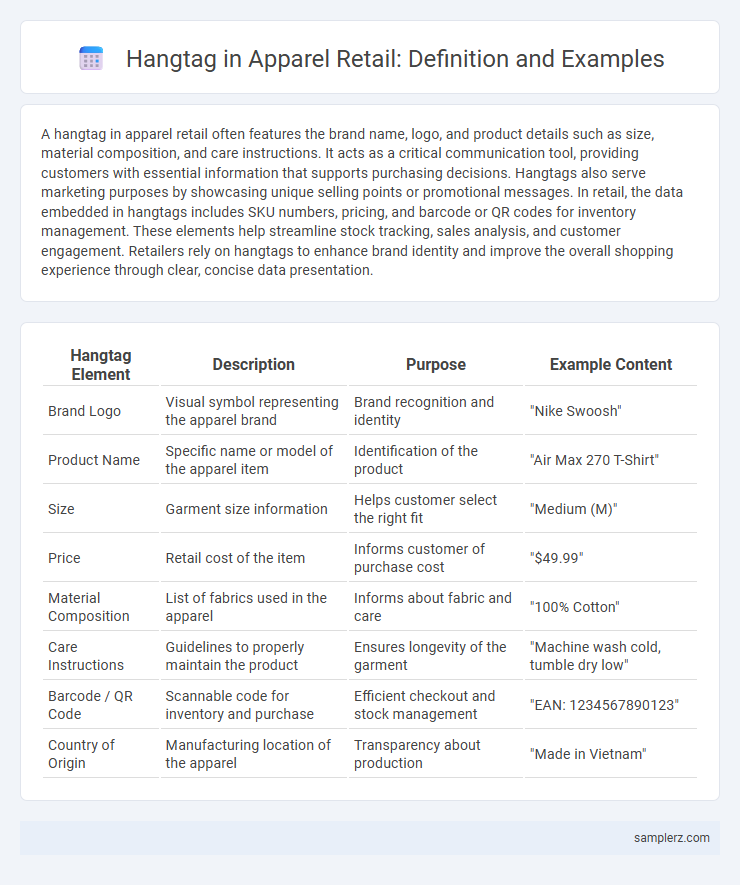A hangtag in apparel retail often features the brand name, logo, and product details such as size, material composition, and care instructions. It acts as a critical communication tool, providing customers with essential information that supports purchasing decisions. Hangtags also serve marketing purposes by showcasing unique selling points or promotional messages. In retail, the data embedded in hangtags includes SKU numbers, pricing, and barcode or QR codes for inventory management. These elements help streamline stock tracking, sales analysis, and customer engagement. Retailers rely on hangtags to enhance brand identity and improve the overall shopping experience through clear, concise data presentation.
Table of Comparison
| Hangtag Element | Description | Purpose | Example Content |
|---|---|---|---|
| Brand Logo | Visual symbol representing the apparel brand | Brand recognition and identity | "Nike Swoosh" |
| Product Name | Specific name or model of the apparel item | Identification of the product | "Air Max 270 T-Shirt" |
| Size | Garment size information | Helps customer select the right fit | "Medium (M)" |
| Price | Retail cost of the item | Informs customer of purchase cost | "$49.99" |
| Material Composition | List of fabrics used in the apparel | Informs about fabric and care | "100% Cotton" |
| Care Instructions | Guidelines to properly maintain the product | Ensures longevity of the garment | "Machine wash cold, tumble dry low" |
| Barcode / QR Code | Scannable code for inventory and purchase | Efficient checkout and stock management | "EAN: 1234567890123" |
| Country of Origin | Manufacturing location of the apparel | Transparency about production | "Made in Vietnam" |
Introduction to Hangtags in Apparel Retail
Hangtags in apparel retail serve as essential branding tools that provide product information such as size, fabric composition, care instructions, and price. These small, printed labels attached to garments enhance customer experience by delivering clear details and reinforcing brand identity. Effective hangtag design can influence purchase decisions and support marketing strategies in competitive retail environments.
Importance of Hangtags for Clothing Brands
Hangtags serve as vital branding tools in the apparel retail sector by conveying key product information such as fabric composition, care instructions, and brand story, which enhances consumer trust and engagement. High-quality, well-designed hangtags can differentiate clothing brands in a competitive market, boosting perceived value and encouraging purchase decisions. Incorporating QR codes or RFID technology into hangtags also offers interactive features that connect shoppers to digital content, promotions, and authenticity verification.
Essential Elements Found on Apparel Hangtags
Apparel hangtags typically feature essential elements such as brand logos, size information, fabric composition, care instructions, and price details to inform and attract consumers. Including barcode or QR codes enhances inventory management and enables quick access to product information. Clear and concise design on hangtags improves shopper experience and reinforces brand identity in retail environments.
Creative Design Trends in Hangtags
Creative design trends in apparel hangtags embrace sustainable materials like recycled paper and plant-based inks to align with eco-conscious consumer values. Innovative shapes and interactive elements, such as QR codes and fold-out designs, enhance brand storytelling and customer engagement. Minimalist typography paired with bold graphics creates a visually striking contrast that captures attention on retail racks.
Sustainability and Eco-Friendly Hangtag Materials
Sustainable hangtags in apparel often utilize recycled paper, organic cotton, or biodegradable materials to minimize environmental impact. Brands are increasingly adopting vegetable-based inks and water-based adhesives to ensure the hangtags remain eco-friendly throughout production and disposal. These innovations reflect a commitment to reducing waste and promoting circular fashion practices within the retail industry.
Examples of Hangtags from Leading Apparel Brands
Leading apparel brands like Nike utilize hangtags to showcase product features and sustainability credentials, prominently displaying material composition and care instructions. Patagonia's hangtags emphasize environmental impact by highlighting recycled fabric content and fair trade certification, reinforcing brand values. Levi's incorporates QR codes on hangtags, allowing customers to access detailed product history and authenticity information instantly.
Personalization and Customization of Hangtags
Personalization and customization of hangtags in apparel retail enhance brand identity and customer engagement by incorporating unique designs, personalized messages, or QR codes that link to exclusive content. Custom hangtags can feature materials such as recycled paper or fabric, aligning with sustainable branding while also providing tactile differentiation. Leveraging data from customer preferences enables tailored hangtag content, boosting customer loyalty and perceived value.
Hangtag Functions Beyond Pricing and Branding
Hangtags in apparel serve multiple functions beyond pricing and branding, such as providing detailed garment care instructions, fabric composition, and sustainability certifications. They can include QR codes that link to extended product information, styling tips, or brand storytelling, enhancing customer engagement. These informational hangtags support transparency, build consumer trust, and improve the overall shopping experience by delivering valuable insights directly on the product.
Tips for Creating Effective Apparel Hangtags
Effective apparel hangtags should feature clear branding elements, such as logos and brand colors, to reinforce brand identity and attract customer attention. Including essential product details like fabric type, care instructions, and size helps shoppers make informed decisions and enhances user experience. Using eco-friendly materials and incorporating QR codes for digital engagement can increase sustainability appeal and provide customers with interactive content.
Future Innovations in Apparel Hangtag Design
Smart hangtags embedded with NFC technology are revolutionizing apparel retail by enabling seamless customer interaction, such as instant product information and authenticity verification. Eco-friendly materials combined with AR (augmented reality) features are enhancing sustainability while providing immersive brand experiences. Integration of QR codes with dynamic content updates allows real-time promotions, improving customer engagement and inventory management.

example of hangtag in apparel Infographic
 samplerz.com
samplerz.com